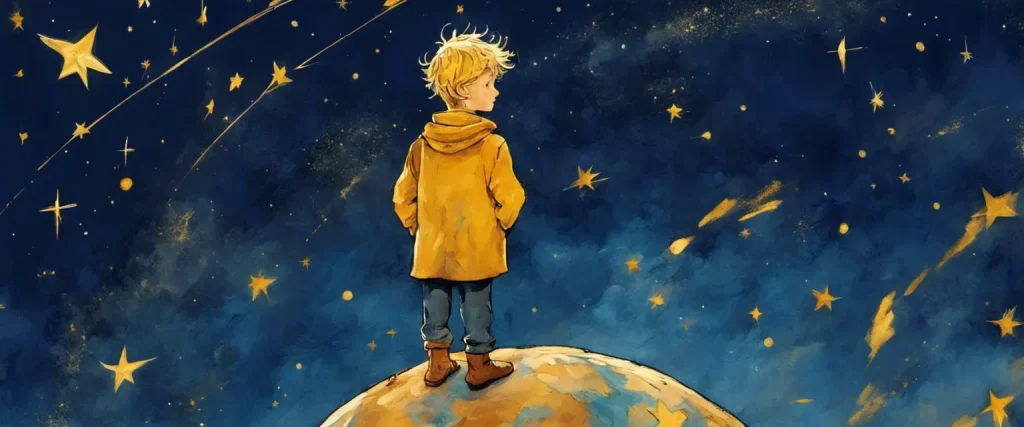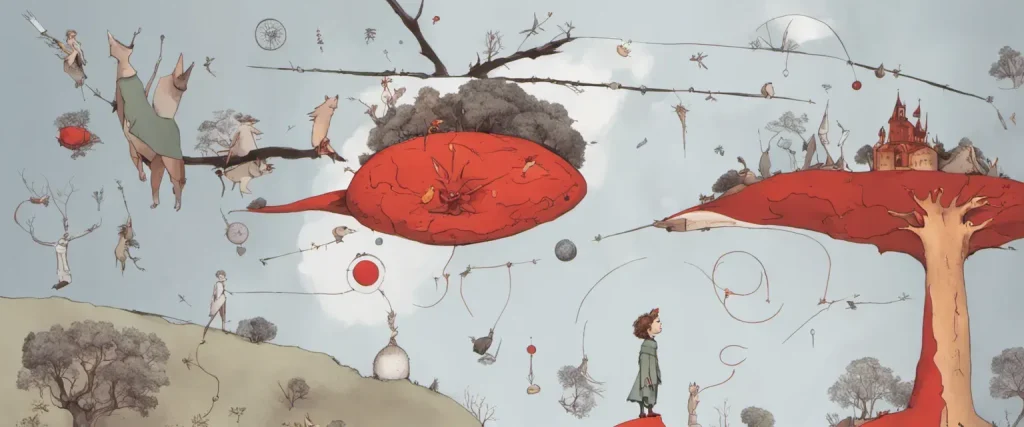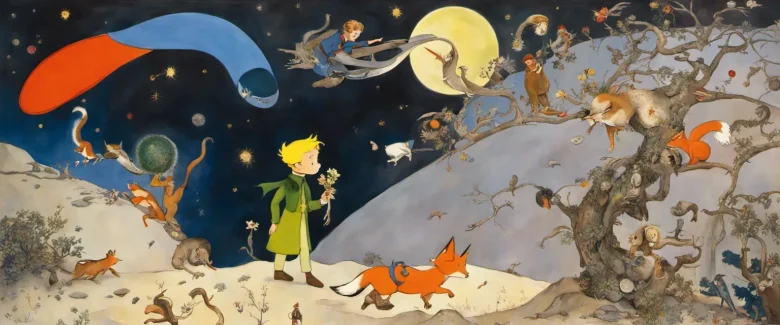The Little Prince, a timeless classic written by Antoine de Saint-Exupéry, takes readers on an enchanting journey filled with profound insights about life, love, and the human condition. This whimsical tale captures the heart of both young and adult readers alike, as it reveals the importance of cherishing the beauty found in simple things. Antoine de Saint-Exupéry, a renowned French aviator and author, drew inspiration from his own experiences as a pilot to craft this captivating allegory, weaving his wisdom and philosophical musings into the fabric of this enchanting tale. Through the delightful adventures of the Little Prince and his encounters with diverse characters, Saint-Exupéry invites readers to reexamine their perspectives and rediscover the magic that lies within their own hearts.
Chapter 1: The Aviator’s Encounter
In Chapter 1 of “The Little Prince” by Antoine de Saint-Exupéry, the Aviator, who is also the narrator of the story, shares his encounter with a little prince. The Aviator recalls his childhood love for drawing, particularly his fascination with drawing boa constrictors that had swallowed animals.
As an adult aviator, the narrator faces challenges in trying to convince adults of the significance of his drawings. One day, he experiences a plane crash in the Sahara Desert, where he is stranded alone with scarce resources. While struggling with dehydration and exhaustion, he encounters a small boy, the little prince, who speaks to him and insists that he draws him a sheep.
The narrator is astonished by the conversation with the little prince, who tells him about his planet, Asteroid B-612, and his journey to various other planets. The little prince shares his experiences with each planet’s inhabitants, including a king, a vain man, a drunkard, a business-minded man, a lamplighter, and a geographer.
Amidst these tales, the little prince expresses his longing to return to his tiny planet and the beloved rose he left behind. The Aviator is captivated by the little prince’s innocence, questioning why adults find childish things unimportant.
This encounter is just the beginning of a profound friendship as the Aviator, through his conversations with the little prince, gains insights into life, love, and the nature of humanity. The Aviator is left contemplating the meaningful lessons he learns from this little boy who seems to possess wisdom far beyond his years.
Chapter 2: The Prince’s Origins
Chapter 2 of “The Little Prince” delves into the origins of the prince himself. The narrator shares his encounter with the little prince after his plane crash-landed in the Sahara Desert. Upon waking up from the crash, the narrator discovers a small boy standing before him, asking him to draw a sheep. The prince’s request puzzles the narrator, who struggles to understand the prince’s fascination with sheep.
As the narrator grows more curious about the prince, he begins to ask him questions, trying to unravel the mystery of his background. The prince reveals that he came from a very small planet, no larger than a house. He describes his planet as having three volcanoes (two of which are dormant) and a beautiful flower. Additionally, the prince shares his responsibility of cleaning the volcanoes, watering the flower, and battling baobab trees that threatened to overtake his planet.
In order to escape the loneliness of his planet, the prince decided to embark on a journey to explore other worlds. His journey first took him to Earth, where his interactions with humans were often baffling and disappointing. He recounts meeting a king who claimed to rule the entire planet, a self-absorbed conceited man, a businessman obsessed with counting stars, and a drunkard who drank to forget the shame of drinking.
The prince’s recollections of his travels provide insight into his innocent yet perceptive nature. As the chapter ends, the prince and the narrator’s growing friendship begins to unfold, with the prince revealing a longing to return to his small planet and his special flower.
Chapter 3: The Fox
Chapter 3 of “The Little Prince” introduces the fox, an important character who plays a significant role in the development of the story. The chapter begins with the little prince discovering a garden full of roses. However, the prince is disheartened by the abundance of roses, as he believed his own rose, back on his planet, was unique and special.
While feeling lonely and misunderstood, the little prince encounters the fox, who asks to be tamed by him. The prince is perplexed by the term “tamed” and asks the fox to explain. The fox shares that taming involves forming a unique and meaningful connection with another being. The fox also emphasizes the importance of spending time and effort to establish trust and create a bond.
Continuing their conversation, the fox reveals that his existence is tied to the prince. The fox explains that the prince will forever remain responsible for the life he has tamed; they will always be connected. This connection deeply touches the little prince, as he realizes the significance and responsibility it entails. The fox also teaches the prince a valuable lesson – seeing with the heart is far more critical than seeing with one’s eyes.
As they spend more time together, the fox expresses sadness, knowing that their time together is limited. The fox shares with the prince his secret understanding of what is truly essential in life. He explains that it’s the time, love, and effort invested in someone or something that makes it unique and meaningful. The fox’s teachings about taming deeply influence the little prince, and from that point on, he cherishes his rose even more, as he has spent time and effort in taming her.
With this newfound wisdom, the little prince’s journey continues, now with a greater understanding of the bond between beings and the significance of personal connections.

Chapter 4: The Snake in the Desert
Chapter 4: The Snake in the Desert of “The Little Prince” introduces the protagonist to a mysterious snake who claims to have the ability to return anyone to their planet. The Little Prince, feeling lonely and homesick, hopes that the snake can help him. As they converse, the snake reveals that he can only grant this wish to those who are willing to sacrifice something in return.
The Little Prince explains his desire to return to his planet, where he left behind a precious rose. The snake advises him to return to the place he came from, the place where his own vulnerabilities lie. He offers an intriguing perspective on mortality, stating that one way to be immortal is to allow something to eat you. The snake stresses that this is not a literal suggestion, but rather a metaphorical one.
Despite his initial disappointment that the snake cannot help him directly, the Little Prince is fascinated by the idea of sacrifice. He ponders over the snake’s words and begins to understand that sacrifice and vulnerability can have significant meaning in life. This conversation with the snake challenges him to reflect on what truly matters to him.
In this chapter, Antoine de Saint-Exupéry explores the themes of sacrifice, longing, and mortality. He prompts readers to consider the value and meaning behind sacrifice, as well as the importance of confronting one’s vulnerabilities. Through the mysterious encounter with the snake, the Little Prince’s journey takes on a deeper introspective tone, setting the stage for further contemplation and self-discovery.
Chapter 5: The Visit to Earth
Chapter 5: The Visit to Earth in the book “The Little Prince” by Antoine de Saint-Exupéry revolves around the little prince’s encounter with various inhabitants of Earth. After leaving his own tiny planet behind, the prince travels through space and lands on Earth, where he meets a snake, a flower, and a fox.
Upon arriving on Earth, the little prince spots a snake and asks for its help in returning to his planet. The snake, however, informs him that it cannot help him with his departure, but may be able to assist in his return at another time. They part ways, leaving the prince with the realization that he will have to find his own way back.
Next, the little prince stumbles upon a flower. Although she initially appears arrogant, the flower reveals her vulnerability and admits her fear of the wind. The prince empathizes with her, feeling responsible for her safety as she is delicate and defenseless.
As the little prince continues his journey, he encounters a fox. They develop a deep connection, and the fox teaches the prince about the importance of human connections and taming. The fox explains that taming is about creating bonds, and that the time invested in another person or creature makes them unique and special. The fox shares the secret of how the prince can tame him, and they become friends. The fox bids the prince farewell, advising him to cherish their bond and all other connections he forms.
Chapter 5 in “The Little Prince” is significant as it illustrates the prince’s encounters with different beings on Earth. Through these interactions, the protagonist learns about empathy, vulnerability, and the value of creating meaningful connections with others. These experiences ultimately shape the little prince’s understanding of the world and his journey towards self-discovery.
Chapter 6: The Rose’s Revelation
In Chapter 6: The Rose’s Revelation of “The Little Prince” by Antoine de Saint-Exupéry, the narrator recounts the encounter when the little prince leaves his asteroid to explore other planets. As he arrives on a new planet, he observes a beautiful rose who makes arrogant claims of being unique among all the flowers in the universe.
The rose, feeling prideful and superior, demands admiration and obedience from the prince. However, her demands and her thorns make him feel doubtful about her uniqueness. Feeling hurt and confused, the prince decides to leave the rose and continue his travels in search of answers.
As he visits other planets, encountering different characters and their idiosyncrasies, the prince slowly realizes that the rose on his asteroid was indeed unique to him. Despite her flaws and demands, she had become an important part of his life.
The prince learns a valuable lesson about love and attachment. He understands that his love for the rose made her special and, in return, she made him special too. Her vulnerability and imperfections were what made her unique in his eyes.
Feeling remorseful for leaving his rose behind, the prince decides to return to her. This decision is a turning point in his journey, as he recognizes the bond and responsibility he has towards his own rose.
Chapter 6 emphasizes the importance of cherishing and appreciating the uniqueness of others, even if they might have flaws. It teaches readers about love, forgiveness, and the significance of relationships in one’s life.
Chapter 7: The Encounter with the Snake
In Chapter 7 of “The Little Prince” by Antoine de Saint-Exupéry, the little prince continues his journey on multiple tiny planets with his unique encounters. On the sixth planet, the little prince meets a mysterious snake.
As the little prince explores the planet, he stumbles upon the snake, who initially frightens him with its strange hissing voice. The snake assures the little prince that he is not a threat and will help him return to his own planet when he desires. The little prince starts to trust the snake, considering the possibility of seeing his rose again.
The snake reveals that he can provide a shorter pathway to reach the planet where the rose resides. Curiously, the little prince asks if the snake can bring him back to his beloved home planet safely. In response, the snake cryptically tells him that everyone will return to where they come from eventually.
The little prince begins to confide in the snake, sharing his melancholy feelings of missing his rose and longing for companionship. He confesses that he regrets leaving his planet and his precious flower behind without properly appreciating them. The snake listens sympathetically and offers comfort, reminding the little prince that he carries both his rose and his planet within himself.
After sharing his story, the little prince decides to depart from the snake. He sincerely thanks the snake for their conversation, knowing that he will always remember it. The chapter ends with the little prince continuing his journey, filled with a newfound sense of hope and understanding.
In this encounter with the snake, the little prince learns to acknowledge his emotions and reflect on the significance of his past experiences. The snake serves as a guiding presence, reminding him of the importance of self-discovery and acceptance.

Chapter 8: The Return
Chapter 8 of “The Little Prince” by Antoine de Saint-Exupéry is titled “The Little Prince’s Return.” In this chapter, the story continues with the pilot’s efforts to fix his plane and his encounters with the little prince.
The pilot, stranded in the desert after a crash landing, becomes busy trying to repair his plane. As he struggles with technical issues, the little prince reappears, encouraging the pilot to look up at the stars and indulge in a beautiful sunset. The little prince talks about his journey to various planets and shares how he encountered various individuals, each symbolizing a different human flaw.
From the prince’s stories, the pilot learns about the conceited man, the drunkard, the businessman, the lamplighter, and the geographer, all of whom the little prince had met on his interplanetary travels. Through these encounters, the book reflects on the absurdity and shallowness of adult life.
As the pilot continues to work on his plane, the little prince wanders off to find a well. This well would provide him with water and allow him to survive in the desert. However, the prince meets a snake along the way and engages in a conversation. The snake offers to help the prince return home by biting him. The prince, seeking to be reunited with his beloved rose on his asteroid, agrees to the snake’s proposal.
The chapter ends on a suspenseful note as the pilot, unable to fix his plane, gives up hope of ever leaving the desert and contemplates his fate.
After Reading
In conclusion, Antoine de Saint-Exupéry’s “The Little Prince” is a profound and captivating book that explores the nature of human relationships and the importance of childlike wonder. Through the encounters of the little prince, the author invites readers to reflect on themes of love, friendship, and the absurdity of adult life. With its timeless messages and poetic prose, this beloved classic serves as a reminder to embrace the beauty of the world and the innocence within ourselves. “The Little Prince” encourages readers to view life through the eyes of a child, reminding us to prioritize what truly matters in our complex and often busy lives.
Book 1: “The Knight in Rusty Armor” by Robert Fisher
This enchanting tale follows the journey of a knight clothed in rusty armor who embarks on a quest to free himself from his external façade and discover his true identity. Through his encounters with various characters, the knight confronts his fears, learns valuable life lessons, and embarks on a transformative journey of self-awareness.
Book 2: “Who Moved My Cheese” by Spencer Johnson
This inspiring parable tells the story of four characters who confront a changing maze in search of cheese – a metaphor for their dreams and desires. As their lives change due to circumstances beyond their control, they must face their fears, embrace change, and learn to navigate the maze of life with newfound resilience.
Book 3: “The Alchemist” by Paulo Coelho
In this modern classic, a young shepherd named Santiago embarks on a journey to discover his personal legend, or true purpose in life. As he encounters various individuals, including an alchemist, he learns lessons about following one’s dreams, overcoming obstacles, and the interconnectedness of the universe. Coelho’s enchanting narrative echoes the profound themes found in “The Little Prince”.
Book 4: “Man’s Search for Meaning” by Viktor E. Frankl
Viktor Frankl, an Austrian psychiatrist and Holocaust survivor, shares his experiences and observations from the darkest depths of human suffering. He recounts how finding meaning and purpose, even in the face of unimaginable adversity, allowed individuals to persevere. This influential book offers profound insights into the pursuit of meaning and the resilience of the human spirit.
Book 5: “The Celestine Prophecy” by James Redfield
Set in the rainforests of Peru, this captivating novel follows the journey of a man seeking a mysterious manuscript containing nine insights. As he delves deeper into the secrets of energy and spirituality, he discovers profound revelations that can transform his own life and the lives of others. This thought-provoking book weaves an engaging narrative with powerful spiritual teachings.



